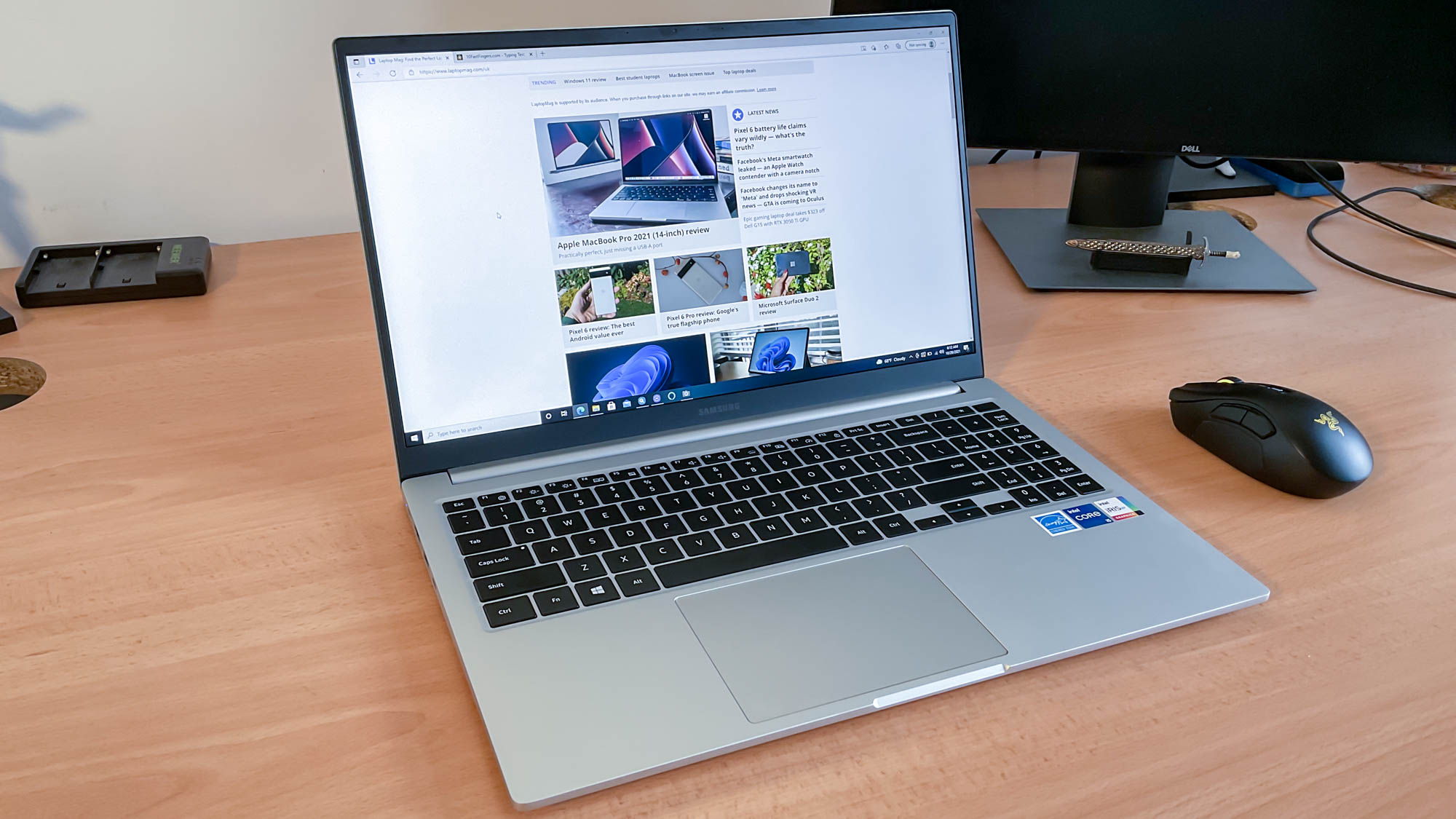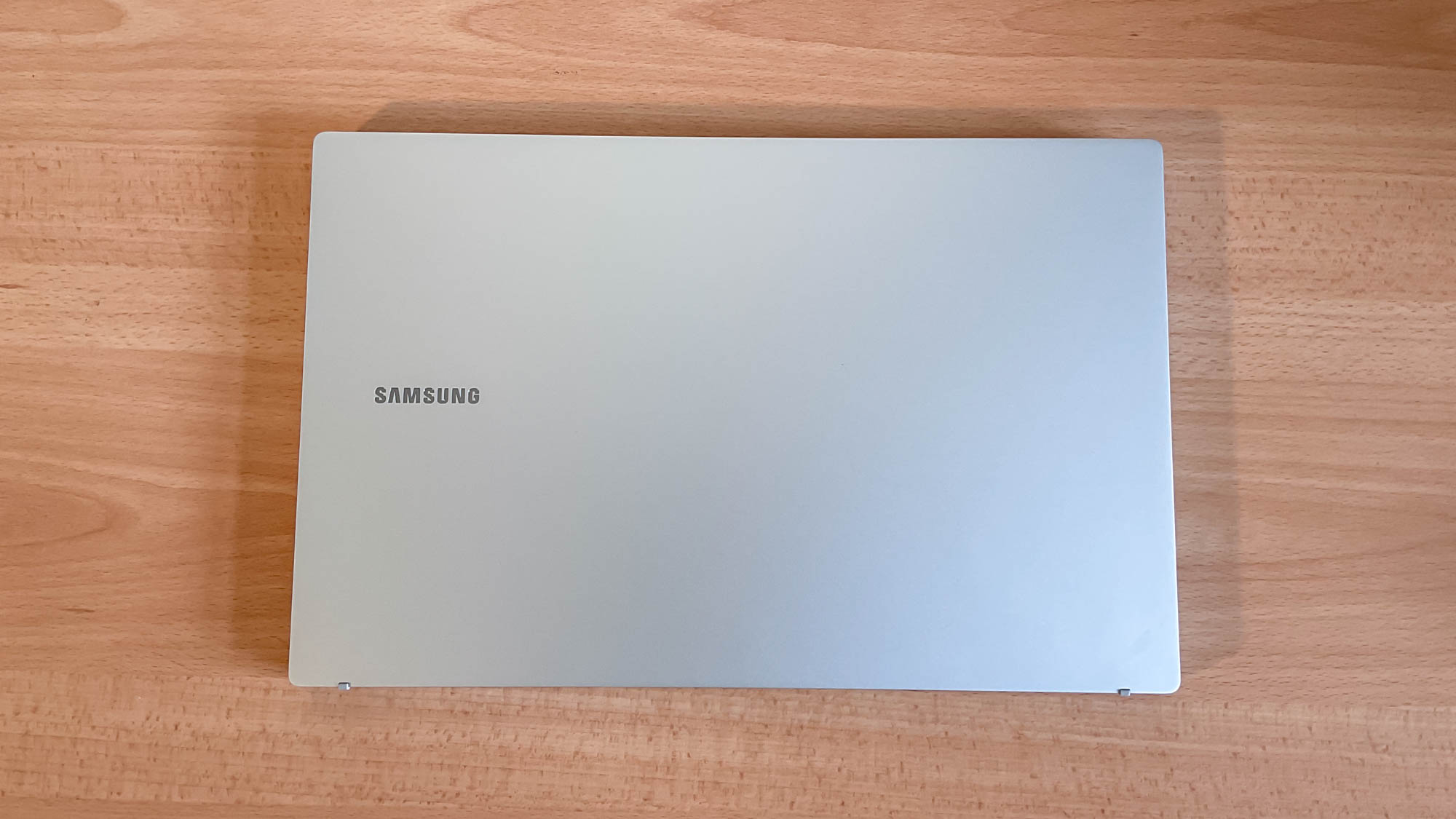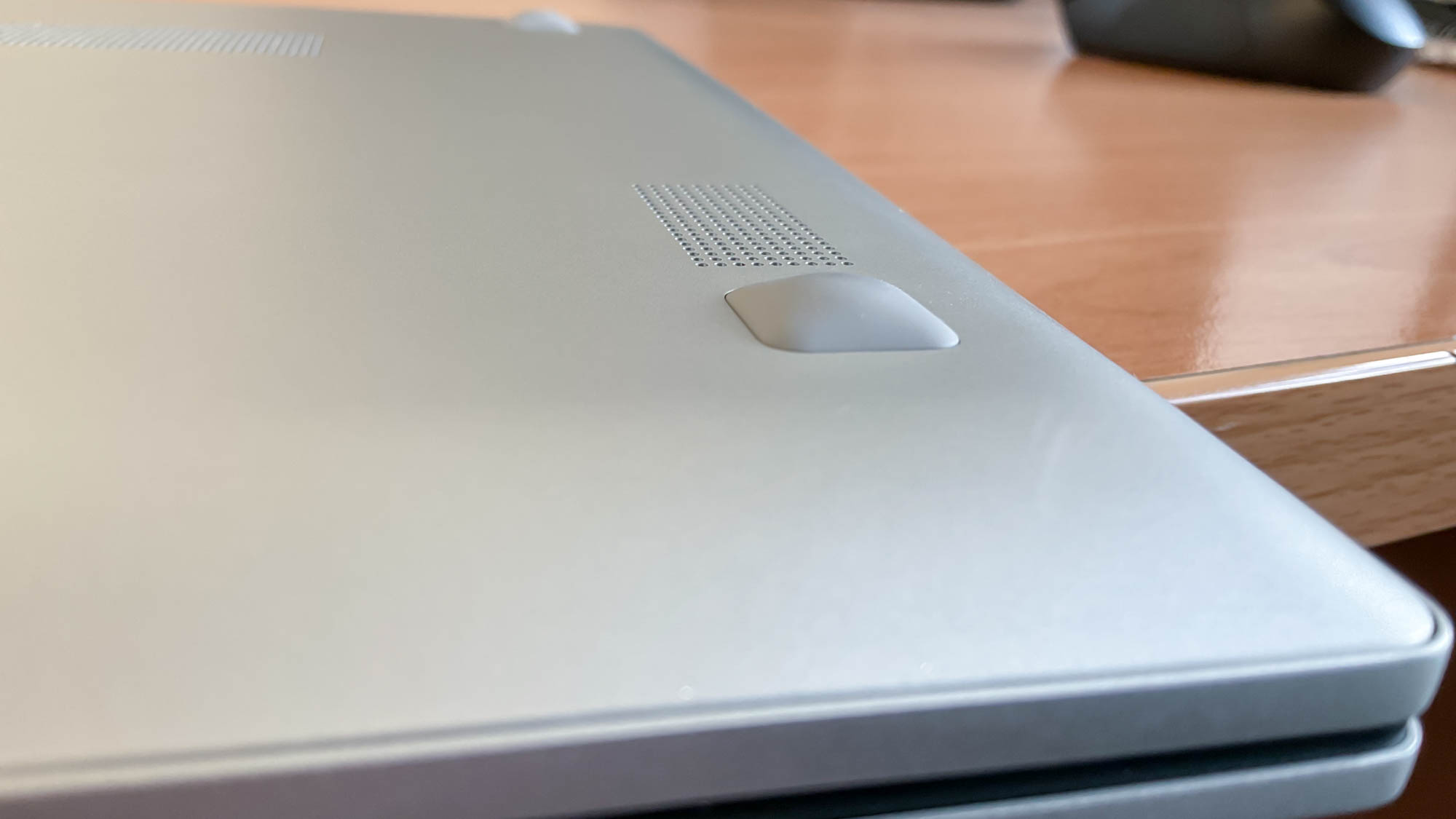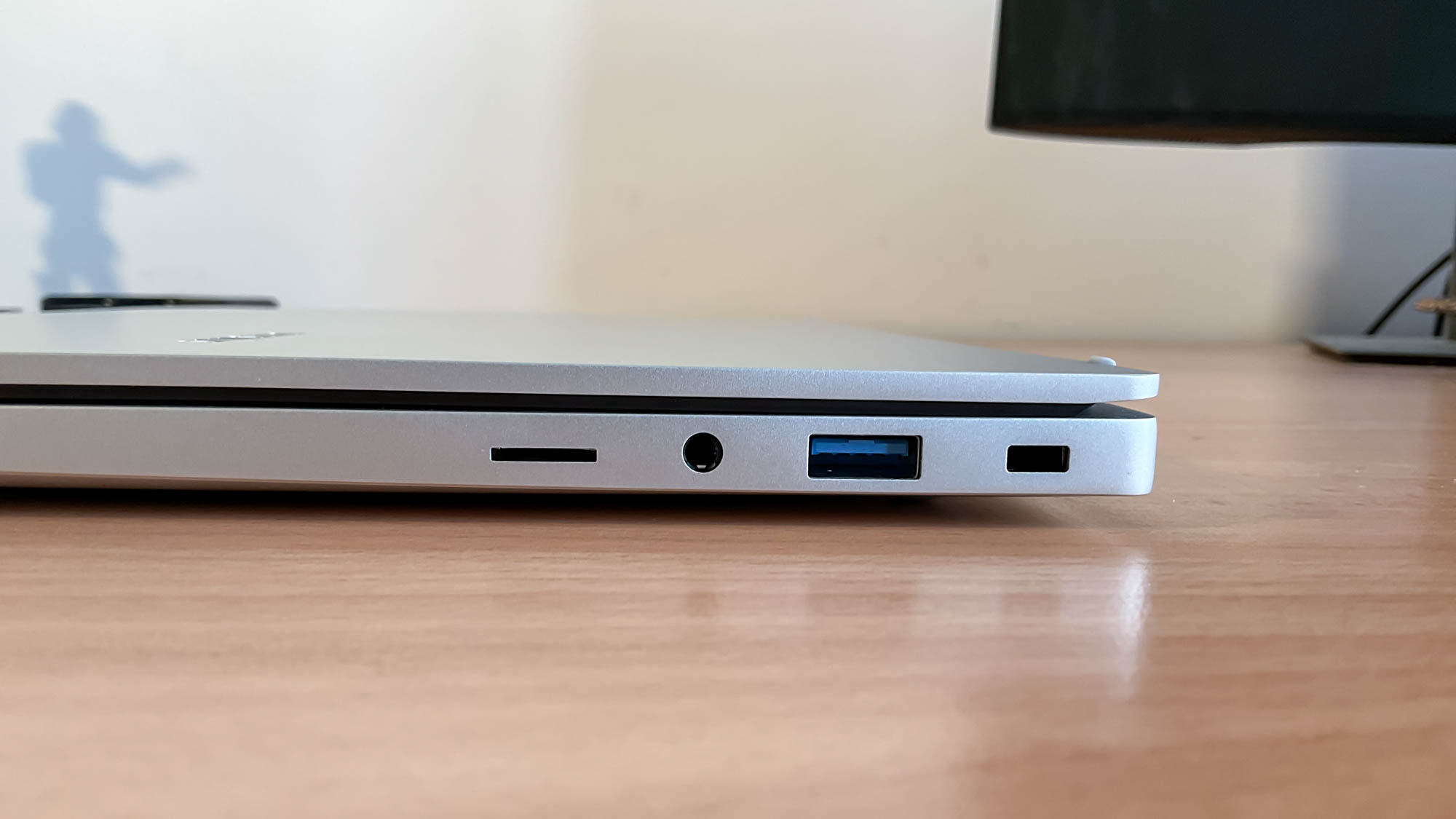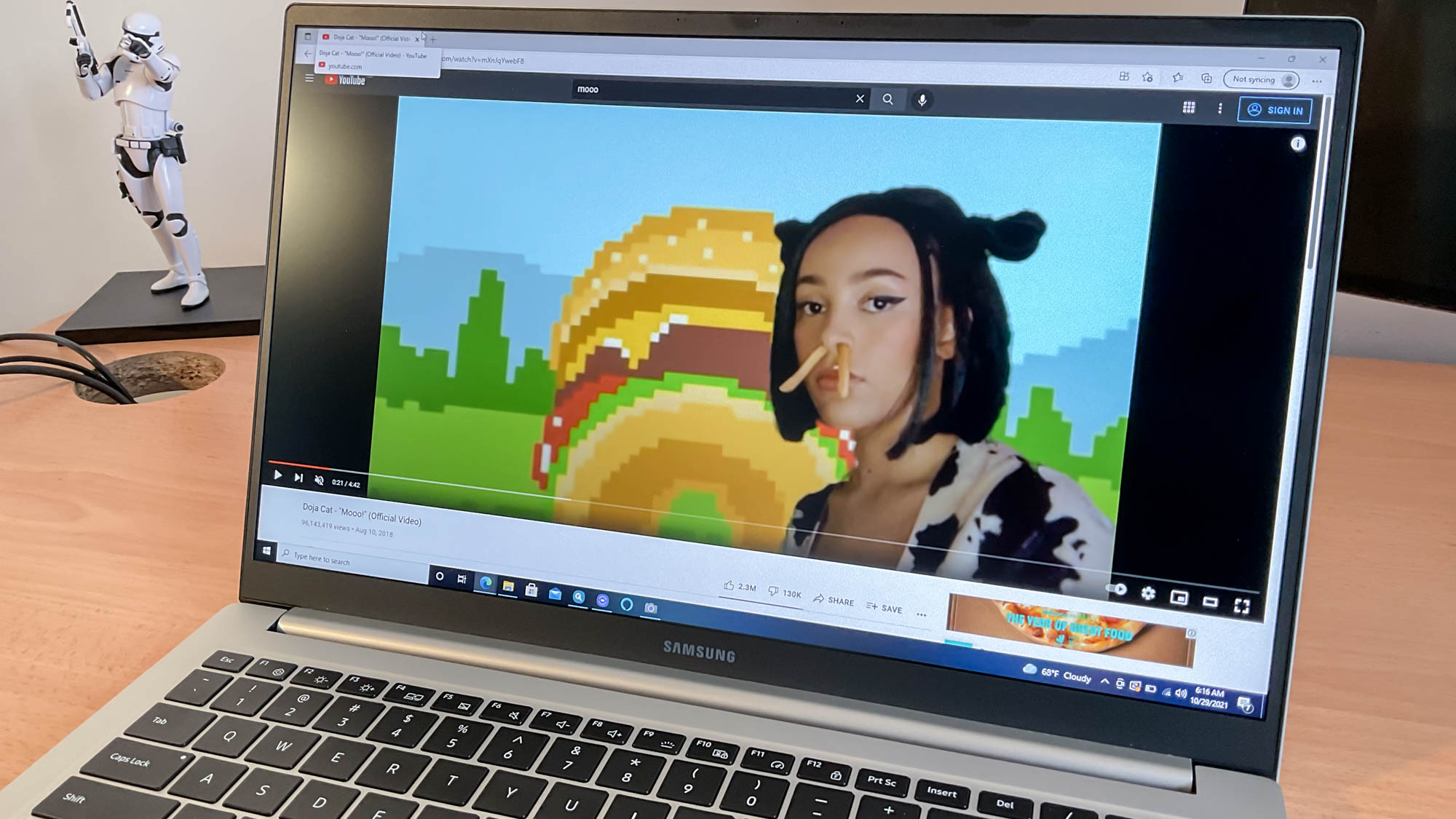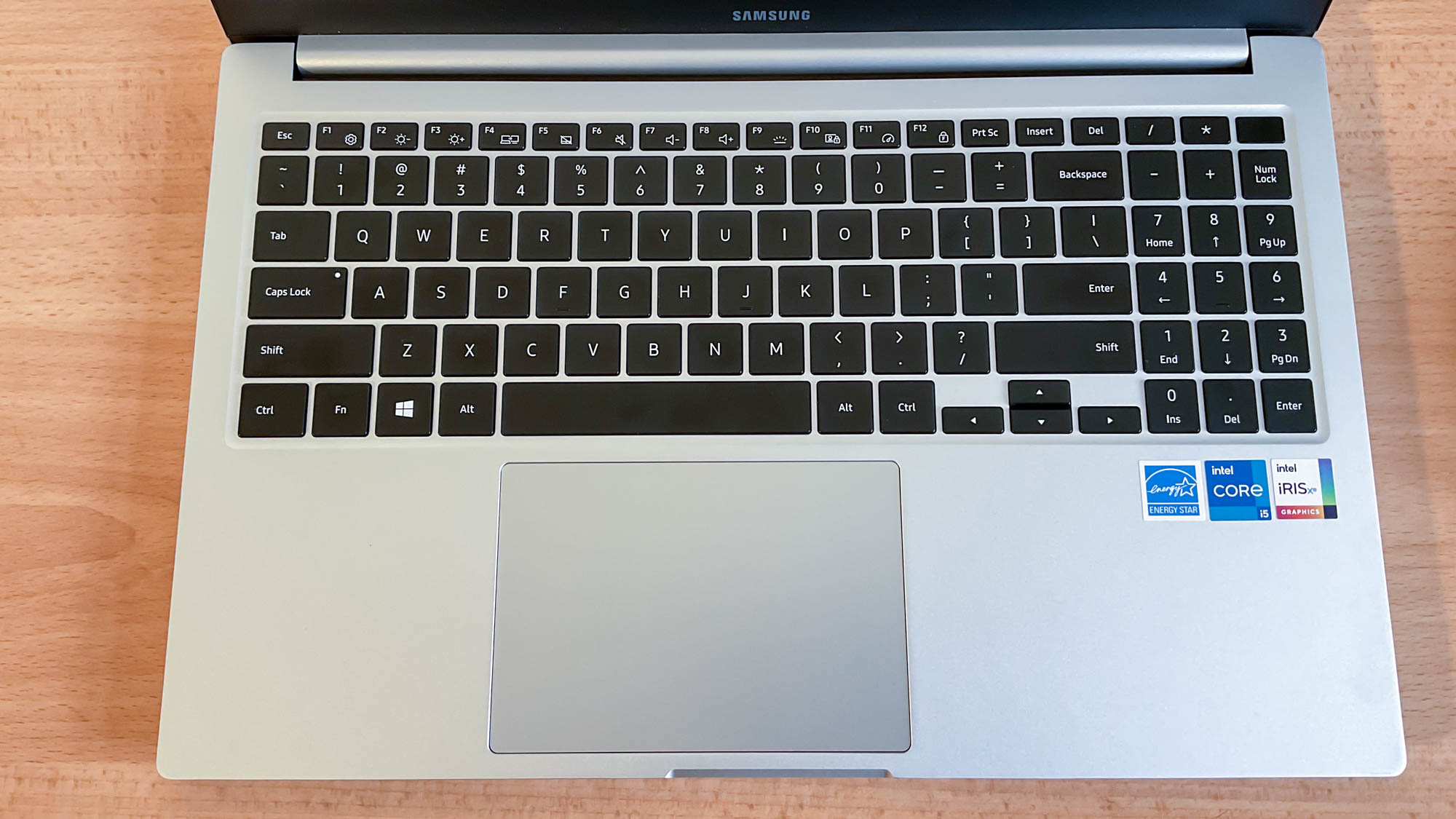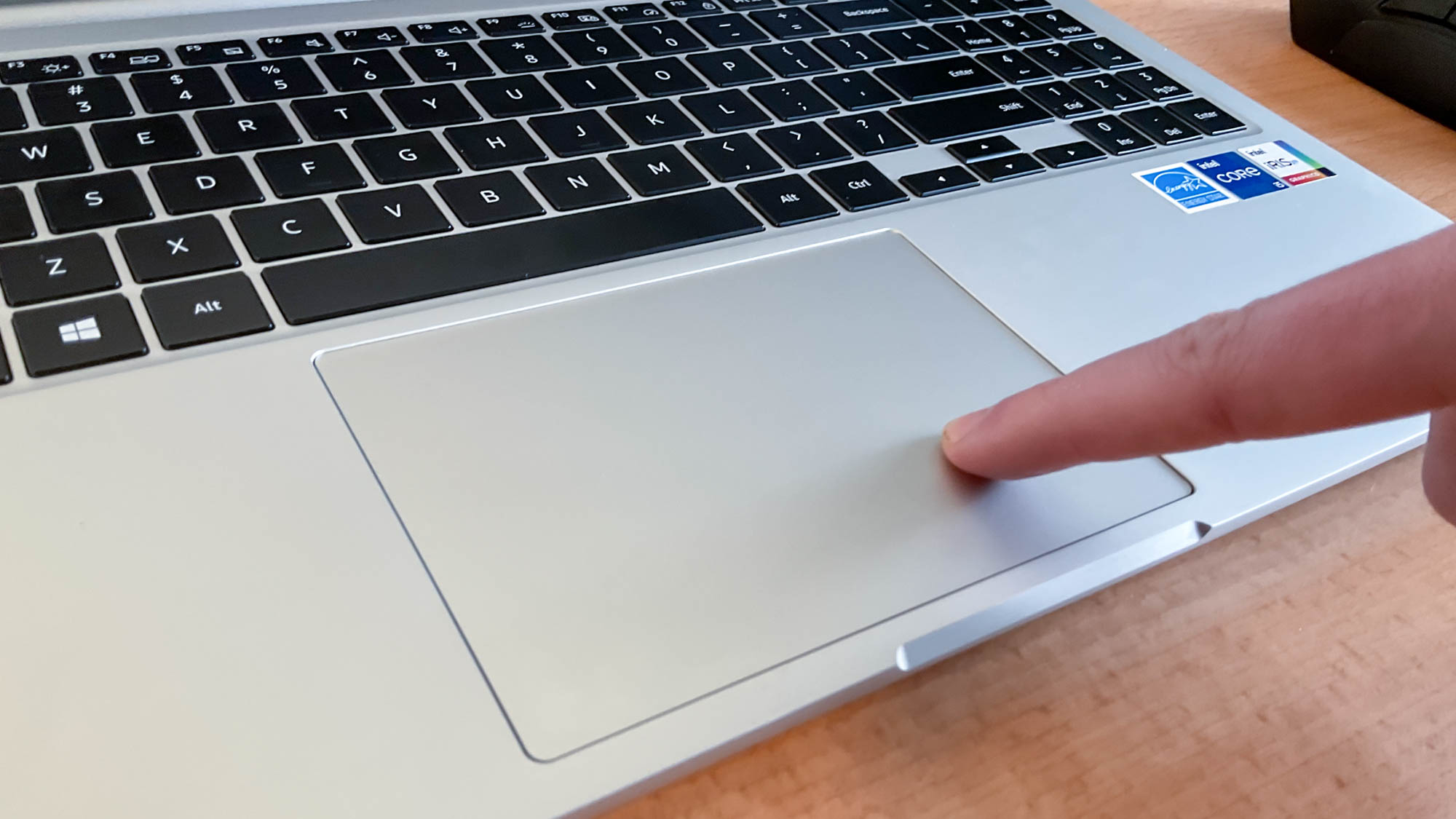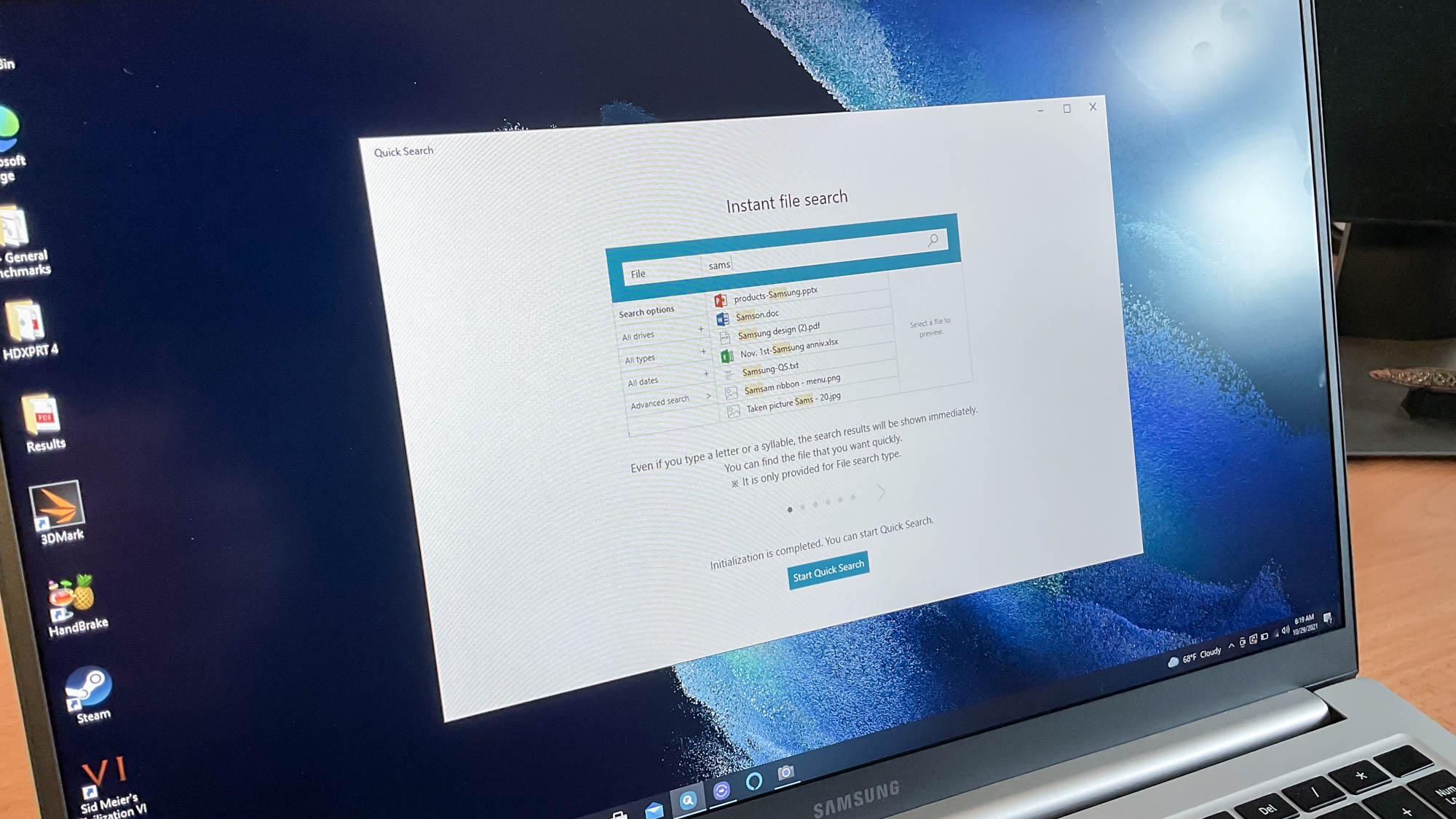Laptop Mag Verdict
With its speedy performance and sub-$1,000 price, the Samsung Galaxy Book impresses, but lacks the battery life and display to truly stand out.
Pros
- +
Amazing Intel 11th Gen performance
- +
Sleek design
- +
Good variety of ports
- +
Decent keyboard
Cons
- -
Poor touchpad
- -
Dull display
- -
Terrible webcam
- -
No backlit keys
Why you can trust Laptop Mag
Price: $899/£799
CPU: Intel Core i5-1135G7
GPU: Intel Iris Xe Graphics
RAM: 8GB
Storage: 256GB
Display: 15-inch FHD LCD (1980 x 1080)
Battery: 10:25
Size: 14.04 x 9.02 x 0.61 inches
Weight: 3.4 pounds
I’ll be blunt: I assumed the latest Samsung Galaxy Book wouldn’t amount to much as soon as I took it out of the box. The 11th Gen Intel processor piqued my interest, but the Core i5 quickly extinguished my excitement. Plus, the typical silver design screamed “I’m like a MacBook, but cheaper!” My already scarce optimism was dwindling fast.
As the saying goes, to assume is to make an “ass” out of “u” and “me,” and I certainly felt like one after using the Galaxy Book for work and entertainment. From its speedy processing power that is only bested by the M1 MacBook Air in the sub-$1,000 category to the comfortable keyboard and variety of ports, Samsung surprised me with an impressive, well-adapted laptop. Still, I have my qualms.
Despite matching the average, the Galaxy Book’s battery life can’t keep up with some major players in the laptop field, while the touchpad makes me want to spend money on a mouse just so I don’t have to use it. What’s more, for such a grand 15-inch display, Samsung didn’t put much effort into the screen. This laptop put my first impressions to shame, but does the Galaxy Book do enough for it to be a worthwhile purchase? Let's find out.
Samsung Galaxy Book price and configurations
The Samsung Galaxy Book B2B edition is available now at Samsung.com and Best Buy, with prices starting from $899/£799, and is now available in the US through samsung.com/business.
The Galaxy Book is available in two configurations, offering users the choice of Wi-Fi or LTE connectivity. The model we received is the Mystic Silver Wi-Fi business edition that includes an Intel Core i5-1135G7, Intel Iris Xe Graphics, 8GB of RAM and 256GB of storage. There is also a Mystic Blue color option available only with this configuration.
For a boost in storage and processing power, the LTE model includes an Intel Core i7-1165G7 CPU, Intel Xe Graphics, 16GB of RAM and a 512GB SSD. This is also available in the Wi-Fi model, but you’ll be stuck with 8GB of RAM. Samsung has yet to announce the pricing for the upgraded specs, but it would need to be below the $1,000 mark to keep up with the competition.
Compared to other travel-friendly notebooks, including the HP Envy 13 (from $849), M1 MacBook Air ($999), Acer Swift 3 ($649) and Lenovo Yoga 7i ($649), the Galaxy Book is priced fairly, especially with the processing power it boasts.
Samsung Galaxy Book design
Samsung is keeping up with the trend Apple set with its MacBooks by doing nothing to make the Galaxy Book stand out in a sea of silver laptops. That is, apart from stamping a “Samsung” logo on the lid. This isn’t necessarily a bad thing, as there’s a sense of quality that comes with a sleek, aluminium design. Still, it would be hard to spot the differences between this and the Samsung Galaxy Book Go.
Fortunately, the Galaxy Book cuts the thick bezels to offer more display real-estate than the Go, and the island-style keyboard with black keys and white letters is spacious and modern — the increased size and numpad is a nice addition. However, expanding the deck made the laptop a bit less travel-friendly for those on the move. While I enjoy the 15-inch screen, the Galaxy Book is big and heavy to carry around in my laptop backpack and it isn’t easy to whip it out on public transportation. Although, this means it makes for a better laptop when placed on a desk.
Speaking of, the rubber feet on the Galaxy Book are more prominent than a lot of laptops I’ve reviewed, allowing it to sit sturdily on a flat surface. It also offers a 180-degree hinge for added flexibility, which is always a nice touch. Other than that, this is your run-of-the-mill thin silver notebook. If you’re after a more unique design, the Mystic Blue color option will be right up your alley.
Measuring 14 x 9 x 0.61 inches and coming in at 3.4 pounds, this is a bigger and heavier notebook than others in the same price range. This includes the HP Envy 13 (12.1 x 7.7 x 0.7 inches, 2.9 pounds), Lenovo Yoga 7i (12.6 x 8.5 x 0.7 inches, 3.1 pounds), Acer Swift 3 (12.7 x 8.6 x 0.67 inches, 2.7 pounds) and MacBook Air (11.9 x 8.4 x 0.6 inches, 2.8 pounds). Keep in mind, these have smaller screens.
Sign up to receive The Snapshot, a free special dispatch from Laptop Mag, in your inbox.
Samsung Galaxy Book ports
The Galaxy Book offers a wide variety of ports, something I wish other notebooks would take note of.
Along the left side are two USB-C ports, an HDMI 2.0 output and a single USB-A 3.2 port.
The right side includes another USB-A 3.2 port, a 3.5mm audio jack and a microSD card reader. This offers enough ports to use multiple PC peripherals, from keyboards to a mouse, or to upload photos and videos from a camera without an adapter.
Samsung Galaxy Book display
The sizable 15-inch, 1080p FHD display begs to be used to binge-watch the latest movies that are finally streaming after the hiatus in 2020. But sadly, the Galaxy Book falls flat in the color department. The panel makes otherwise impressive scenes look dull, but at least it offers a bright enough display.
When watching the final trailer for Dune (a must-watch, by the way), the planet Arrakis didn’t look so great when the sun was low. The “Spice” twinkling while rolling over the sands looked more like mush than anything, while the deep blue eyes of Zendaya’s Fremen character Chani are not nearly as mesmerizing as the movie depicts them to be. Having said that, while the display could be better, it isn’t a deal-breaker.
Covering only 43.7% of the DCI-P3 color gamut, the Galaxy Book is shamefully worse than the already terrible panel found on the Swift 3 (44%), and is well behind the Envy 13 (80%), Yoga 7i (80%) and MacBook Air (81%). The category average surpasses even the more capable machines at 84%.
As for brightness, the Galaxy Book fairs better, reaching an average of 319 nits. This is still significantly less than the category average of 390 nits, but it does lap the Yoga 7i (266 nits) and the Swift 3 (251 nits). However, it falls behind the Envy 13 (361 nits) and MacBook Air (386 nits).
Samsung Galaxy Book audio
I’ve been told to be more experimental when listening to music, so I tested the Samsung Galaxy Book’s speaker by playing Doja Cat’s “Mooo!” To my delight, the chilled beats were satisfyingly pronounced, while Doja Cat serenaded me with her pleasant “mooos,” which weren’t drowned out by the soft guitar melodies playing in the background.
For a bit more rock n’ roll, I turned up the volume to hear the high pitched yodeling in “Hocus Pocus” by Focus. Despite it being an old tune, I was jamming to distinct guitar riffs and brilliant drum solos thanks to the laptop’s Dolby Atmos audio system. While I was impressed by the audio quality, I wish the speakers got louder, as I never needed to turn them down so I didn’t disturb neighbours (not that I would, of course). Rock on, Focus.
Samsung Galaxy Book keyboard and touchpad
It’s hard to believe that a keyboard and touchpad on the same laptop could be so different in quality, but that is the case with the Galaxy Book.
The keyboard offers a similar tactile feel as the best notebooks on the market, much like what you’d find on a MacBook. Keys are satisfying to press, and despite the short travel distance, they felt punchy without making any cheap clicky sounds. On the 10FastFingers.com typing test, I reached 75 words per minute. This was better than my 72 wpm average. Be warned, however, as this Galaxy Book doesn’t have backlit keys, making it troublesome to type on those long nights.
When it comes to the touchpad, slow, sticky and imprecise are the words that come to mind. The 4.7 x 3.3-inch plastic touchpad feels cheap, and I heard a squeak every time I moved the cursor to close or open a tab. It was also hard to tell the difference between the left- and right-click buttons, resulting in times when I wanted to quickly close a tab, only to be met with a drop-down menu. It’s a small annoyance that can get intolerable when you need to get a job done, post-haste.
For those who no longer want to deal with lame touchpads, check out our best mouse page.
Samsung Galaxy Book performance
This is where the Samsung Galaxy Book gets to shine. The performance of the Intel Core i5-1135G7 proves a Core i5 should not be underestimated. In fact, it offers more than enough power for the general user, which means the Core i5 is the more favourable option since it keeps the price down over the Core i7 config. Still, the Galaxy Book lacks in certain areas.
I put the Galaxy Book to the test by throwing 30 Microsoft Edge tabs at it, which included two Google Docs, a couple of YouTube videos playing in the background, along with a scroll through Instagram. It was a piece of cake for the laptop, as I witnessed no stuttering or lag when switching between tabs. This is a delight for any multi-tasker who needs an assortment of tabs open to get their work done.
Starting with Geekbench 5.4 in our benchmark tests, the Galaxy Book reached an impressive 4,984 overall performance score. This outperforms a lot of its competition, including the best 13-inch laptop, the HP Envy 13 (4,930), which sports the same processor. The Galaxy Book beat the Lenovo Yoga 7i (4,538, Core i5-1135G7) and the Acer Swift 3 (4,895, Ryzen 7 4700U), but couldn’t come close to the M1 MacBook Air (7,575).
During our video editing test, the Galaxy Book also performed well as it only needed 14 minutes and 9 seconds to convert a 4K clip to 1080p resolution. This is well below the 15:58 category average, and blazed past the Envy 13 (17:29) and Yoga 7i (14:59). The Swift 3 (11:00) and MacBook Air (9:15) were the laptops to beat, but the Galaxy Book sits comfortably in third place.
When testing the Galaxy Book’s 256GB NVMe SSD, it couldn’t keep up by a long shot. It converted a 25GB multimedia file at a rate of 162.1 megabytes per second (MBps), which is atrocious when compared to the category average (622.5 MBps). The Envy 13 (415.6, 256GB SSD), Yoga 7i (311 MBps, 512GB SSD), and Swift 3 (462.7 MBps, 512GB SSD) completely trampled over the Galaxy Book, which is disappointing seeing how well it performed in all other categories.
Samsung Galaxy Book graphics
The Samsung Galaxy Book’s Intel Iris Xe Graphics isn’t meant to play the latest AAA games like Halo Infinite, but it can display 4K videos, load busy web pages and even run photo editing software for general users. What’s more, the laptop surpasses what many others in the field.
On the 3DMark Fire Strike benchmark, the Galaxy Book scored 4,280, which goes above and beyond the Envy 13 (3,709), Yoga 7i (2,025) and the Swift 3 (2,847). Even with creator laptops with discrete GPUs thrown into the category average (4,774), the Galaxy Book does a fine job.
When playing Sid Meier's Civilization VI: Gathering Storm (1080p), the Galaxy Book ran the popular turn-based strategy at a comfortable 33 frames per second. While not the standard 60 fps many look for today, this is still enough oomph to play through the game. The Galaxy Book could handle games much better than the Envy 13 (18 fps, Iris Xe), Yoga 7i (27 fps, Iris Xe) and Swift 3 (18 fps, AMD Radeon). It was well over the 28 fps average.
Samsung Galaxy Book battery life
Battery life isn’t the Samsung Galaxy Book’s strong suit, but it still offers over the standard 10 hours. In the Laptop Mag battery test, which consists of continuous web surfing over Wi-Fi at 150 nits, the Galaxy Book lasted an average of 10 hours and 25 minutes, beating the category average of 10:15.
The Galaxy Book trailed behind other long-lasting laptops, including the HP Envy 13 (11:15), Swift 3 (11:09), Yoga 7i (12:36) and, of course, the MacBook Air (14:41) set a new standard in laptop battery life.
Samsung Galaxy Book webcam
Hello, 720p webcam. We meet again on yet another laptop, and you’re as grainy as I remember.
In a world where smartphones, such as the iPhone 13, feature excellent front-facing cameras and budget tablets like the Xiaomi Pad 5 can support 1080p resolution, it’s a shame a business-orientated laptop can’t muster a quality shooter. More often than not, a laptop’s camera is the only means for professionals to show their faces during work calls. Due to the COVID-19 pandemic, video conferencing has become an essential part of many people’s lives, which makes a grainy, off-color webcam that struggles to capture details in low light a problem.
In this picture I took in low light, there is graininess in nearly every pixel, making it impossible to see that each picture frame with Scrabble tiles has bold letters on them. My facial hair looks like someone pulled out a fat marker to fill in the appropriate spaces, while it’s hard to tell my eye color’s green/blue-ish hue. To put this into perspective, the more affordable $349 Samsung Galaxy Book Go has the same 720p shooter.
At least there is a webcam, which is more than what a lot of laptops can boast. Still, since this notebook is targeted for traveling professionals, the Samsung Galaxy Book leaves a lot to be desired. Check out our best external webcams page to get something that will make your video-conferencing calls look more professional.
Samsung Galaxy Book heat
Samsung’s Galaxy Book can handle the heat when put under pressure, keeping nice and cool when running a 15-minute 1080p video. During our heat test, the underside of the laptop hit 85.5 degrees Fahrenheit, which is well below our 95-degree comfort threshold. The touchpad remained the coolest, scoring 78.5 degrees, while the center of the keyboard reached 86 degrees. You’ll find the hottest location of the laptop can be found on the underside of the Galaxy Book near the vents, which clocked in at 89.5 degrees.
Samsung Galaxy Book software and warranty
The Galaxy Book comes with Windows 10 Pro, even though Windows 11 is out and slowly becoming the new standard. There are some pre-installed apps such as Samsung’s Quick Search and Quick Share apps, which are far more welcome than the Booking.com Partner App (Samsung Edition).
Apps like Quick Share, which lets users instantly transfer data from their Galaxy devices to the Samsung laptop, are handy for those who own other Samsung devices, like the Samsung Galaxy S21 Ultra or Samsung Galaxy Tab S7. The Galaxy ecosystem is expanding for the better, and it comes with plenty of niche perks including quick pairing with the Samsung Galaxy Buds 2, SmartThings which lets users control other devices from the laptop, along with the Second Screen feature that offers a multi-screen experience for those with a Galaxy Tab.
The Galaxy Book comes with a three-year limited warranty. See how Samsung fared on our Tech Support Showdown and Best and Worst Brands special reports.
Bottom line
Samsung is getting good at developing laptops. That’s not to say its past efforts were failures, but it hasn’t quite reached the heights of being a leader in the market like it has with its Samsung Galaxy smartphones. However, the Samsung Galaxy Book 2021 is putting the company on a path to greatness. Not only does its 11th Gen Intel Core i5 processor impress by delivering fantastic overall performance for a $750 laptop, but its decent keyboard, port variety and thin design make it a promising notebook for professionals.
With the ARM Exynos processor for laptops Samsung is expected to be working on, it’s exciting to see how the company will make its line of Galaxy Books even better. Still, there are some cogs that need some polishing to make the machine flow. While the laptop’s thin bezels make the most of the 15-inch display, the panel itself is dull. Samsung also needs to do something about their terrible touchpad and webcam, especially if it's promoting the latter by stating it can put on an “impressive video presentation”.
The Samsung Galaxy Book is a good laptop, especially for those with other Samsung devices. If you’re looking for something extra, let me point you in the direction of the Samsung Galaxy Book Pro 360 — a laptop you don’t want to pass up. For more affordable laptops, check out the best laptops under $1,000.

Darragh Murphy is fascinated by all things bizarre, which usually leads to assorted coverage varying from washing machines designed for AirPods to the mischievous world of cyberattacks. Whether it's connecting Scar from The Lion King to two-factor authentication or turning his love for gadgets into a fabricated rap battle from 8 Mile, he believes there’s always a quirky spin to be made. With a Master’s degree in Magazine Journalism from The University of Sheffield, along with short stints at Kerrang! and Exposed Magazine, Darragh started his career writing about the tech industry at Time Out Dubai and ShortList Dubai, covering everything from the latest iPhone models and Huawei laptops to massive Esports events in the Middle East. Now, he can be found proudly diving into gaming, gadgets, and letting readers know the joys of docking stations for Laptop Mag.

